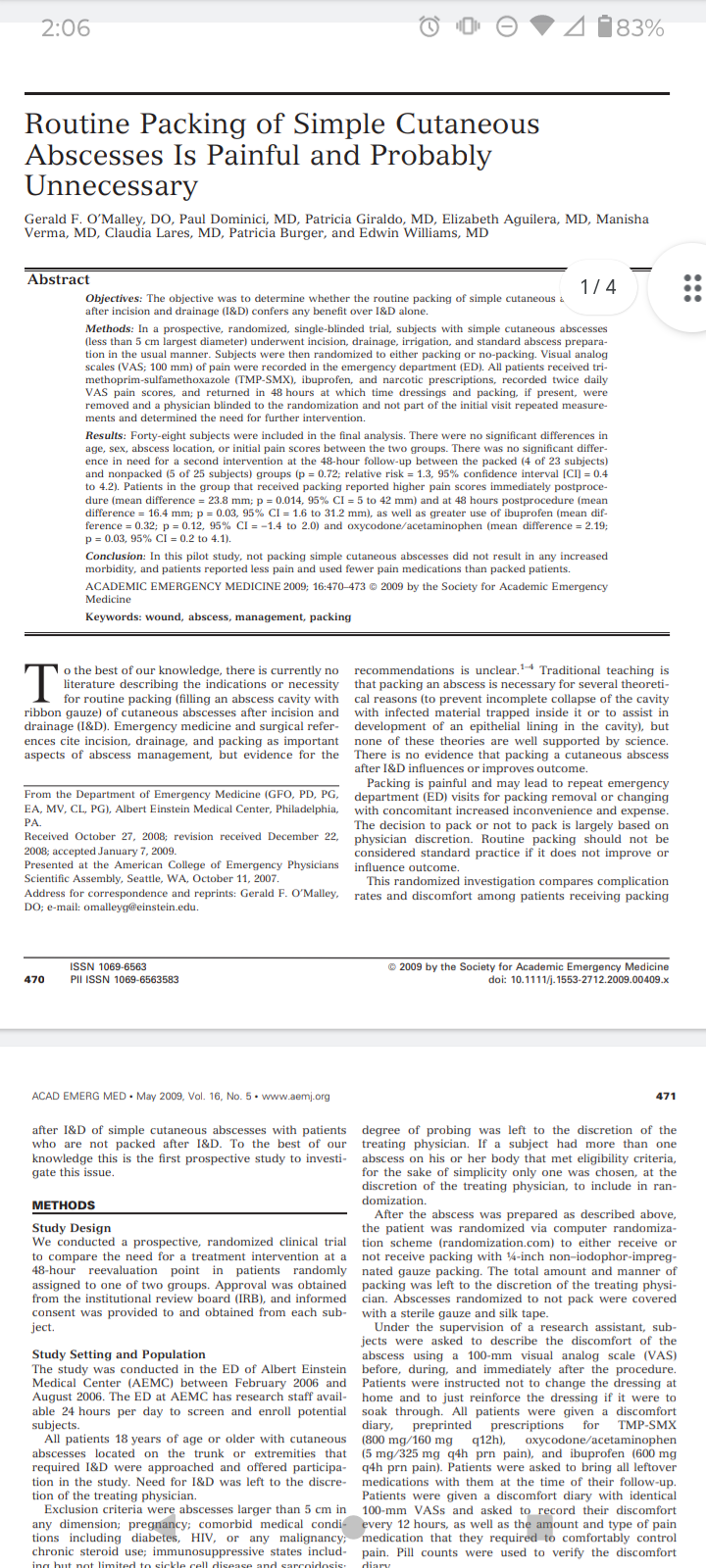Stop Packing Abscesses!
Written by Damian Baalmann, M.D. and reviewed by Dustin Leigh, M.D.
A 49 year-old, previously healthy female presents to your emergency department with chief complaint of a boil on her left thigh. Otherwise, the patient denies any fevers, chills, systemic symptoms. The patient first noted this boil 3 days ago and it has since grown in size and is painful to touch. Vitals reveal that she is normotensive, not tachycardic, afebrile and satting well on room air. Exam reveals 4-cm tender, fluctuant, erythematous nodule on the lateral aspect of the mid left thigh. No apparent overlying cellulitis or lymphadenopathy and the rest of the physical exam is within normal limits. Quick look with bedside ultrasound confirms your suspicion of a non-loculated, cutaneous, drainable abscess. Your nursing staff has kindly already brought lidocaine/epinephrine, a scalpel, 25-gaugle needle, syringe, normal saline, and for some reason, packing supplies to the bedside.
To Pack or Not To Pack
Abscesses are the most common dermatological conditions managed by emergency physicians. [1] Treatment of an abscess is drainage and may involve irrigation, primary versus secondary closure, and antibiotic treatment. The intricacies of the techniques (large incision vs small incision), irrigation, closure, and antibiotic treatment are generally case dependent and not supported with robust literature and will not be discussed in this post. The topic of this post is whether to pack or not to pack cutaneous abscesses. Historically, cutaneous abscesses have been packed sterilely with wicks to promote epithelial lining of the abscess cavity and to prevent entrapment of the bacteria in the abscess. Typically, the patient would then be instructed to return to the emergency department for repacking or sent home with packing materials to self-pack until the wound has healed.
It has been argued that there is no evidence-based science behind packing of cutaneous abscesses that have been incised and drained. Because of this lack of evidence, two randomized controlled trials have somewhat recently been performed.
- O’Malley et al. performed a RCT of 48 patients in 2009. All 48 patients had abscesses <5-cm and were incised, drained, had loculations broke-up, and washed as per provider discretion. Additionally all patients were given antibiotics and pain medicine. Twenty-three of these patients were assigned to a packing group whose abscesses were packed with iodoform gauze and 25 patients to a non-packing group whose abscesses were covered with sterile gauze and tape. Primary outcome was need for intervention at return visit 48-hours after enrollment and there was no significant difference between the groups. Secondary outcomes included pain scores pre-procedure, post-procedure, and 48 hours post-procedure. While there was no significant difference in pre-procedure pain, there was significantly higher pain in the packed group in both the post-procedure and 48 hour post-procedure groups. Additionally, the packed group took on average 2.19 more Percocet pills (p=0.03) than their non-packed counterparts. [2]
- Kessler et al. performed a RCT of 57 pediatric and adult patients (average age: 18y/o) in 2012. In this study, patients underwent I&D in a somewhat standardized fashion and 29 patients were randomized into a packing group and 28 were randomized to non-packing. Some were lost to follow-up, but the rest were re-evaluated at 48 hours, 1 week, and 1 month. Failure rates at 48 hours were high in both groups (70% in the packed group and 59% in the non-packed group) but were not significantly different. There was also no significant difference in need for interventions, reoccurrence of abscesses, pain differences, and return to the emergency department. [3]
In 2011, Schmitz et al surveyed 350 emergency medicine providers regarding abscesses and found that 91% of these providers still packed abscesses following I&D. [4]
Upon our review of the current literature we found insufficient evidence to support routine packing of subcutaneous abscess. While most studies have been small with few RTC’s there does not appear to be evidence of increased recurrence of abscesses when not packed. However, multiple studies do identify increased patient discomfort. There is probably no benefit to packing cutaneous abscesses as it does not appear to prevent reoccurrence of abscesses or decreasing further intervention at follow-up. There is probably harm with packing abscesses as may be an associated increase in pain post-procedure and at 48-hour follow-up. Bottom line: do not pack cutaneous abscesses.
Case Revisited
You opt to not reach for the packing gauze on the table and send the patient out after I&D. After return instructions are given, she leaves with an understanding to return if worsening or not improving.
More Reading
Want to know more about abscesses? Check out this great review article about “Management of Skin Abscesses in the Era of Methicillin-Resistant Staphylococcus aureus” [5]
References
- Niska, R., F. Bhuiya, and J. Xu, National Hospital Ambulatory Medical Care Survey: 2007 emergency department summary. National health statistics reports, 2010(26): p. 1-31.
- O'Malley, G.F., et al., Routine packing of simple cutaneous abscesses is painful and probably unnecessary. Academic emergency medicine : official journal of the Society for Academic Emergency Medicine, 2009. 16(5): p. 470-3.
- Kessler, D.O., A. Krantz, and M. Mojica, Randomized trial comparing wound packing to no wound packing following incision and drainage of superficial skin abscesses in the pediatric emergency department. Pediatric emergency care, 2012. 28(6): p. 514-7.
- Schmitz, G., et al., The treatment of cutaneous abscesses: comparison of
- emergency medicine providers' practice patterns. The western journal of emergency medicine, 2013. 14(1): p. 23-8.
- Singer, A.J. and D.A. Talan, Management of skin abscesses in the era of methicillin-resistant Staphylococcus aureus. The New England journal of medicine, 2014. 370(11): p. 1039-47.

